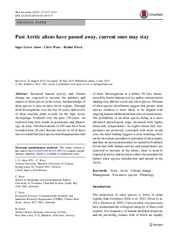Past Arctic aliens have passed away, current ones may stay
Permanent link
https://hdl.handle.net/10037/9020Date
2015-07-04Type
Journal articleTidsskriftartikkel
Peer reviewed
Abstract
Increased human activity and climate change are expected to increase the numbers and impact of alien species in the Arctic, but knowledge of alien species is poor in most Arctic regions. Through field investigations over the last 10 years, and review of alien vascular plant records for the high Arctic Archipelago Svalbard over the past 130 years, we explored long term trends in persistence and phenology. In total, 448 observations of 105 taxa have been recorded from 28 sites. Recent surveys at 18 of these sites revealed that alien species had disappeared at half of them. Investigations at a further 49 sites characterised by former human activity and/or current tourist landing sites did not reveal any alien species. Patterns of alien species distribution suggest that greater alien species richness is more likely to be aligned with ongoing human inhabitation than sites of transient use. The probability of an alien species being in a more advanced phenological stage increased with higher mean July temperatures. As higher mean July temperatures are positively correlated with more recent year, the latter finding suggests a clear warming effect on the increased reproductive potential of alien plants, and thus an increased potential for spread in Svalbard. Given that both human activity and temperatures are expected to increase in the future, there is need to respond in policy and action to reduce the potential for further alien species introduction and spread in the Arctic.
Description
Published version. Source at http://doi.org/10.1007/s10530-015-0937-9.


 English
English norsk
norsk